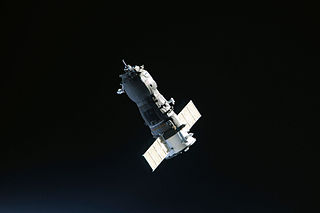 W
WUncrewed spacecraft or unmanned spacecraft are spacecraft without people on board, used for robotic spaceflight. Uncrewed spacecraft may have varying levels of autonomy from human input; they may be remote controlled, remote guided or even autonomous, meaning they have a pre-programmed list of operations, which they will execute unless otherwise instructed.
 W
WDragon C208 is the first Cargo Dragon 2 spacecraft, and the first in a line of International Space Station resupply craft which replaced the Dragon capsule, manufactured by SpaceX. The mission is contracted by NASA under the Commercial Resupply Services (CRS) program. It flew for the first time on the CRS-21 mission on 6 December 2020. This was the first flight for SpaceX under NASA's CRS Phase 2 contract awarded in January 2016. This was also the first time a Cargo Dragon was docked at the same time as a Crew Dragon spacecraft. This mission used Booster B1058.4.
 W
WCargo spacecraft are robotic spacecraft that are designed to carry cargo, possibly to support space stations' operation by transporting food, propellant and other supplies. This is different from space probes, whose missions are to conduct scientific investigations.
 W
WCrew Dragon C205 is a Crew Dragon capsule manufactured and built by SpaceX. It completed its first flight on January 19, 2020, with the Crew Dragon In-Flight Abort Test mission where the capsule detached from the Falcon 9 B1046 booster at max Q using the SuperDraco abort thrusters. This was done to test the functionality of the abort thrusters in an operational rocket launch.
 W
WUncrewed spaceflights to the International Space Station (ISS) are made primarily to deliver cargo, however several Russian modules have also docked to the outpost following uncrewed launches. Resupply missions typically use the Russian Progress spacecraft, European Automated Transfer Vehicles, Japanese Kounotori vehicles, and the American Dragon and Cygnus spacecraft. The primary docking system for Progress spacecraft is the automated Kurs system, with the manual TORU system as a backup. ATVs also use Kurs, however they are not equipped with TORU. Progress and ATV can remain docked for up to six months. The other spacecraft — the Japanese HTV, the SpaceX Dragon and the Northrop Grumman Cygnus — rendezvous with the station before being grappled using Canadarm2 and berthed at the nadir port of the Harmony or Unity module for one to two months. Under CRS phase 2, Cargo Dragon will dock autonomously at IDA-2 or 3 as the case may be. As of April 2021, Progress spacecraft have flown most of the uncrewed missions to the ISS.
 W
WSince 1958, NASA has overseen more than 1,000 uncrewed missions into Earth orbit or beyond. It has both launched its own missions and provided funding for private-sector missions. A number of NASA missions, including the Explorers Program, Voyager program, and New Frontiers program, are ongoing.
 W
WA robotic spacecraft is an uncrewed spacecraft, usually under telerobotic control. A robotic spacecraft designed to make scientific research measurements is often called a space probe. Many space missions are more suited to telerobotic rather than crewed operation, due to lower cost and lower risk factors. In addition, some planetary destinations such as Venus or the vicinity of Jupiter are too hostile for human survival, given current technology. Outer planets such as Saturn, Uranus, and Neptune are too distant to reach with current crewed spacecraft technology, so telerobotic probes are the only way to explore them.
 W
WA space telescope or space observatory is a telescope located in outer space to observe distant planets, galaxies and other astronomical objects. Space telescopes avoid the filtering of ultraviolet frequencies, X-rays and gamma rays; the distortion (scintillation) of electromagnetic radiation; as well as light pollution which ground-based observatories encounter.
 W
WA space probe or a spaceprobe is a robotic spacecraft that does not orbit the Earth, but instead explores farther into outer space. A space probe may approach the Moon; travel through interplanetary space; flyby, orbit, or land or fly on other planetary bodies; or enter interstellar space.